by Kathy Torres
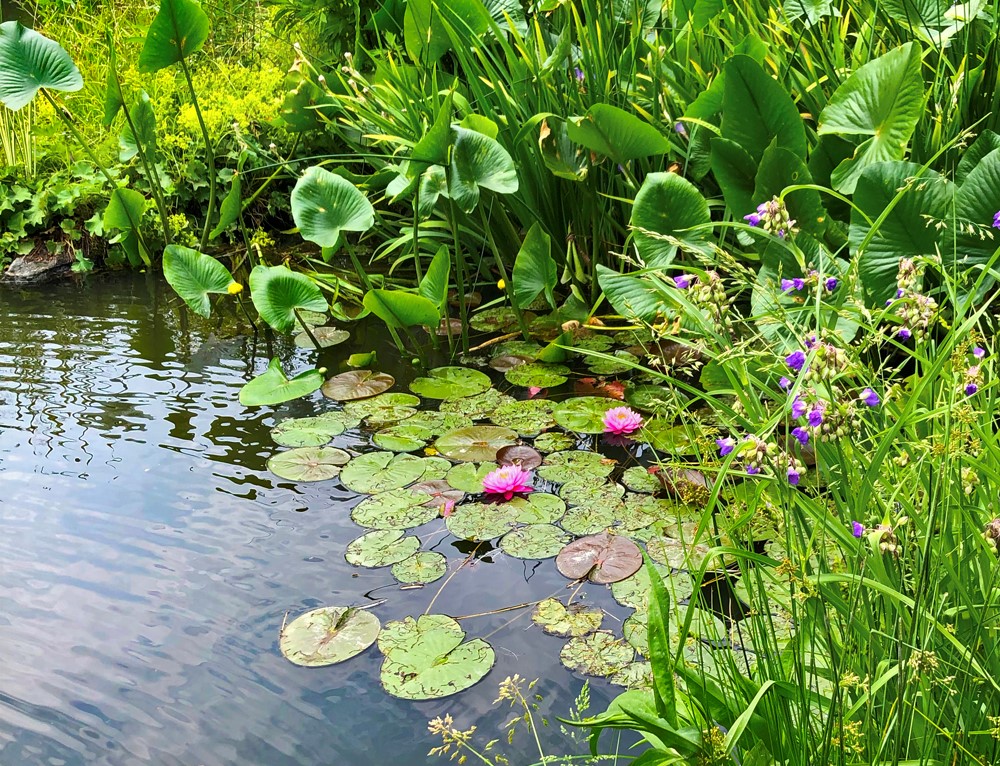 The sights and sounds of water provide a relaxing, soothing atmosphere in the garden. An extra reward is the attraction of pollinators, frogs, butterflies, and other beneficial wildlife. As water gardens and ponds have gained popularity, so has interest in plant life to enhance the natural appearance of these landscape additions. There are many aquatic plants for use in natural, as well as man made water features that, in addition to just being beautiful, add oxygen, help to control algae and provide a home or hiding place for wildlife.
The sights and sounds of water provide a relaxing, soothing atmosphere in the garden. An extra reward is the attraction of pollinators, frogs, butterflies, and other beneficial wildlife. As water gardens and ponds have gained popularity, so has interest in plant life to enhance the natural appearance of these landscape additions. There are many aquatic plants for use in natural, as well as man made water features that, in addition to just being beautiful, add oxygen, help to control algae and provide a home or hiding place for wildlife.
Different aquatic plants require different depths of water, so it is important to do a little research and choose plants that will best suit your particular conditions. Some aquatic varieties just like to have wet feet, as in a bog situation. Other plants need to be fully submerged, and some float on the surface with their roots hanging in water. You can achieve the proper level for one or multiple plants by placing bricks, cinder blocks, etc. under the pots.
Specialty pots, soil, gravel, and fertilizers are available for aquatic plants. Soil should be loamy and heavy so that it won’t float away when the pot is placed in water. Potting mix is not suitable, as it will float out of the pot and muck up the water. Aquatic or pea gravel can be added on top of the soil to hold it in place. Some water gardeners also plant completely in gravel. It’s good to experiment to see what works best for you. It may be appropriate to plant bare root directly into the pond or water feature, using rocks to hold the plant in place. Just be sure to remove all the dirt from the roots before it goes in the water.
An aquatic garden will require some tending, as far as plant growth is concerned. Because many water plants are bulbs that will multiply, it will likely be necessary to divide them as they outgrow their space. Avoid cultivars that are invasive. Go to https://hgic.clemson.edu/factsheet/aquatic-shoreline-plant-selection/ for a listing of nuisance (and illegal) water plants in South Carolina.
With any plant, it is key to be aware of the mature size as you make plans to include it in any part of the landscape to make the most of your space and avoid overcrowding. Plant a variety of heights, leaf shapes, and blooming specimens to give dimension and interest to your water garden. Also key, is the sunlight requirement. Many aquatic plants like full sun to part shade, but make sure before you put them in place. Of course, one really great benefit in a water garden is the ability you have to move plants around! Make sure taller plants don’t block sunlight to smaller ones. Know which plants are vulnerable to colder temperatures in the winter months; you may need to take them out and keep them in a warmer place.
Consider the following categories and examples when making your selection of aquatic plants:
BOG & MARGINAL AQUATIC PLANTS – These specimens bridge the gap between water and dry land. Bog plants enjoy moist soil around the edge of ponds, with water just covering or slightly below the soil. Marginal aquatic plants, the most abundant of water plants, thrive in the shallow waters at the inside edge with an average water depth up to 6 inches over the crown.
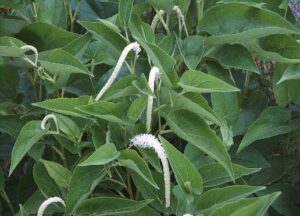 Saururus cernuus AKA Lizard’s Tail – Deep green heart shaped leaves. Gracefully arching spikes of tiny white flowers 4-6 in. shaped like a lizard’s tail. Will flower even in dense shade. The plant grows to height of 3-4 feet. Plant in a medium pot with water from 1-6 in. over crown of plant.
Saururus cernuus AKA Lizard’s Tail – Deep green heart shaped leaves. Gracefully arching spikes of tiny white flowers 4-6 in. shaped like a lizard’s tail. Will flower even in dense shade. The plant grows to height of 3-4 feet. Plant in a medium pot with water from 1-6 in. over crown of plant.
 Lobelia fulgens ‘Queen Victoria’ AKA Cardinal Flower provides interest all season with rich burgundy foliage. Upright stalks can grow to heights of 2-3 ft. Striking red flowers in late summer. May be planted in 1-3 inches of water. Grow in sun to part shade.
Lobelia fulgens ‘Queen Victoria’ AKA Cardinal Flower provides interest all season with rich burgundy foliage. Upright stalks can grow to heights of 2-3 ft. Striking red flowers in late summer. May be planted in 1-3 inches of water. Grow in sun to part shade.
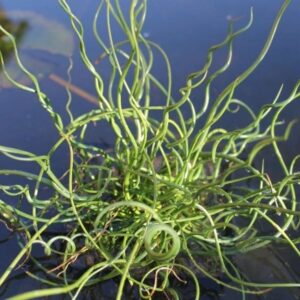 Juncus effuses ‘Spiralis,’ commonly known as Corkscrew Rush has attractive corkscrew stems which are both upright and prostrate, cylindrical, green, and smooth. They grow in 1-6 inches of water over the crown into a clump 12-18 inches tall and wide with late summer yellowish-green flowers. Full sun is best but some shade can be tolerated.
Juncus effuses ‘Spiralis,’ commonly known as Corkscrew Rush has attractive corkscrew stems which are both upright and prostrate, cylindrical, green, and smooth. They grow in 1-6 inches of water over the crown into a clump 12-18 inches tall and wide with late summer yellowish-green flowers. Full sun is best but some shade can be tolerated.
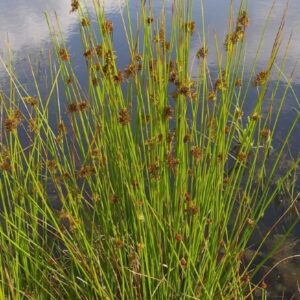 Juncus effusus / Soft Rush – Soft, grass like stems grow in clumps that rarely intrude upon other plants. Each stem bears a cluster of very small, greenish brown, scaly flowers that bloom in July through September from a point on the stalk near the top. Grows to a height up to 1 ft. tall.
Juncus effusus / Soft Rush – Soft, grass like stems grow in clumps that rarely intrude upon other plants. Each stem bears a cluster of very small, greenish brown, scaly flowers that bloom in July through September from a point on the stalk near the top. Grows to a height up to 1 ft. tall.
DEEP WATER PLANTS – These water plants flourish in the deeper recesses of the pond. With the crown fully submerged beneath water, many (such as Water Lilies) produce foliage on long stems that float at the water’s surface.
Water Lilies are a group of plants containing about 70 known species. They are either tropical or hardy and grow in water 3 inches to 2 feet deep. Larger plants need larger water gardens or ponds. They prefer non-moving water without fountains or currents. Most prefer full sun but some will tolerate shade. The flowers are showy and usually fragrant with showy lily pads for leaves.
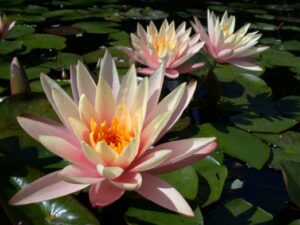 Nymphaea ‘Georgia Peach’ is a hardy, free-flowering, showy water lily with a long bloom season. Blooms stand 3-4 inches above the water surface. It is very adaptable to different growing situations. Use in medium to large water gardens.
Nymphaea ‘Georgia Peach’ is a hardy, free-flowering, showy water lily with a long bloom season. Blooms stand 3-4 inches above the water surface. It is very adaptable to different growing situations. Use in medium to large water gardens.
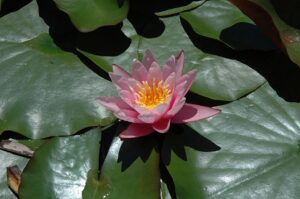 Nymphaea Pink ‘Sensation’ is considered one of the best hardy pink water lilies. Blooms are held above the waterline, stay open later in the day, are free-flowering and have a slight fragrance. Use in any size water garden.
Nymphaea Pink ‘Sensation’ is considered one of the best hardy pink water lilies. Blooms are held above the waterline, stay open later in the day, are free-flowering and have a slight fragrance. Use in any size water garden.
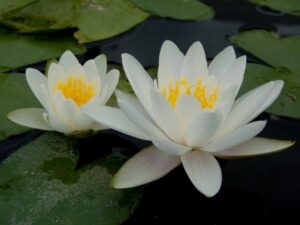 Nymphaea Albatros has beautiful, star-shaped, snow white flowers. A free flowering hardy white water lily, it will perform well in full sun or partial shade. The new foliage is deep burgundy and turns a deep olive green as it matures. Flowers stay open later in the day.
Nymphaea Albatros has beautiful, star-shaped, snow white flowers. A free flowering hardy white water lily, it will perform well in full sun or partial shade. The new foliage is deep burgundy and turns a deep olive green as it matures. Flowers stay open later in the day.
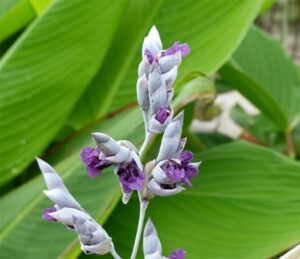 Thalia Dealbata AKA Hardy Water Canna – Purple flowers on top of tall, graceful stems. Large blue-green leaves. Will grow to heights of 4-6 feet. Do not allow crown of plant to freeze during winter. Plant in a medium pot with water from 1-2 ft. over crown of plant.
Thalia Dealbata AKA Hardy Water Canna – Purple flowers on top of tall, graceful stems. Large blue-green leaves. Will grow to heights of 4-6 feet. Do not allow crown of plant to freeze during winter. Plant in a medium pot with water from 1-2 ft. over crown of plant.
SUBMERGED OXYGENATORS will create a healthy pond with well oxygenated water, essential for fish and wildlife to flourish. Many submerged aquatic plants are sold as bunches of stems that can be weighted or planted into pots to anchor them at the bottom of the pods.
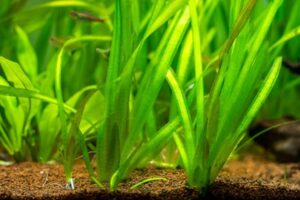 Vallisneria americana AKA Water Celery is an evergreen perennial with clusters of ribbon-like leaves, about 1 inch wide that can grow up to 3 ft. long, producing single white flowers that grow to the water surface. After pollination, the flower stalks curl into spirals and pull the flowers underwater, where they form capsules containing many tiny seeds. Very fast grower, able to reach full height in 2 months. Performs best in full sun to light shade in water 12-48 inches deep.
Vallisneria americana AKA Water Celery is an evergreen perennial with clusters of ribbon-like leaves, about 1 inch wide that can grow up to 3 ft. long, producing single white flowers that grow to the water surface. After pollination, the flower stalks curl into spirals and pull the flowers underwater, where they form capsules containing many tiny seeds. Very fast grower, able to reach full height in 2 months. Performs best in full sun to light shade in water 12-48 inches deep.
Come in and check out the inventory of aquatic plants and supplies at Wingard’s. We’re showing them off in a brand new display!

